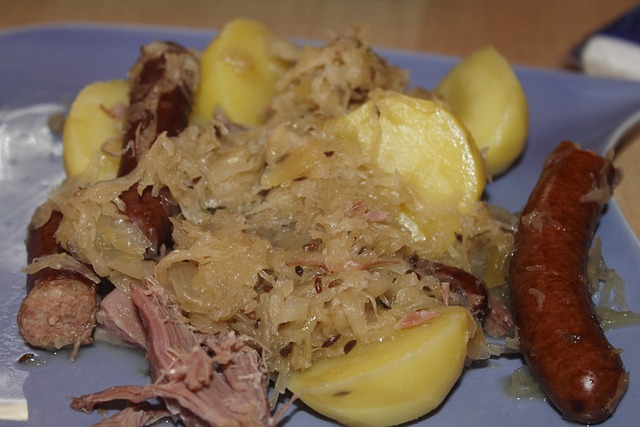Today, the world is more at our fingertips than ever before. You can go to any major city and enjoy the cuisine of dozens of countries, or, if you’re more adventurous, go online and find recipes and videos showing you how to cook food from literally every corner of the globe. And while this is great for expanding your culinary horizons, it also brings with it the curious revelation that not all the foods we know and love are actually from where we always thought they were. Some of your international favorites may not be international at all.
10. Spaghetti and meatballs aren't technically Italian.

Is there any dish more Italian than spaghetti and meatballs? Well, actually, many of them are, since it's not technically an Italian dish at all. That's not to say spaghetti isn't Italian, and of course meatballs can be Italian, but most countries have meatballs, too. But the dish we all now understand as spaghetti and meatballs is 100% American, at the expense of Italy.
Traditional Italian meatballs could be made with any type of meat, from fish to turkey, and while beef was an option, it wasn't as plentiful in Italy as it was in America, so it was a less likely choice. Additionally, Italian meatballs were more often served as a separate dish or in soups, rather than on top of pasta. In fact, in Italy, you're very unlikely to find spaghetti and meatballs on a menu unless it's a tourist trap targeting foreign visitors.
When Italians began immigrating to America, they naturally brought their cuisine with them, including meatball recipes. There was more meat in America and cheaper, than before, so new meatball recipes have adapted to be made with ground beef, and they have become larger.
The fact that dried pasta and canned tomatoes were also readily available and cheap meant that a dish roughly similar to what they might have eaten at home could be prepared cheaply and efficiently, and spaghetti and meatballs were born. The dish dates back to somewhere between 1880 and 1920.
9. Chicken Parmesan - American cuisine with an Italian twist
Sticking with non-Italian Italian, another extremely tasty and popular dish, chicken parmesan, is as Italian as spaghetti and meatballs. That means it was inspired by Italy but made in the USA.
If you're not familiar, the dish typically consists of chicken breasts, usually pounded, breaded and fried until crispy, served over tomato sauce and topped with melted cheese.
You won't find this dish in Italy, but you will find eggplant parmesan , which is almost the same but made with eggplant instead of chicken. The dish originates from Sicily, and the evolution of eggplant into chicken is very similar to the evolution of the meatball. Italian immigrants to the United States encountered different ingredients and cheaper meat. Changes in the recipe allowed for the replacement of chicken, as meat proved to be a very popular option in America, and so the chicken version was born.
The chicken pate recipe was published in the New York Times in 1962 , and since then the dish has become a staple in Italian-American restaurants.
8. Italian clothing comes from America
One last look at Italy, and this time at the world of salad. While ranch tops the list of America's favorite salad dressings, Italian takes second place , at least according to one survey. Surprisingly, this is an exclusively American result, since Italian clothing is not even an option in Italy.
Ask anyone who has lived in both Italy and America and they will point out that the Italian dressing you can buy in grocery stores is in no way similar to what you get on your salad in Italy, it's usually just olive oil and vinegar .
American Italian clothing seems to have been invented, or at least popularized, Florence Hannah , whose parents were Italian immigrants. She made salad dressing at the Massachusetts restaurant she ran with her husband, Ken, which led to Ken's Foods, the company that still bottles it.
7. German chocolate cake is not German
People consume about 7.5 million tons chocolate a year, or about two pounds for every living person in the world. It's safe to say that people really like it. And German chocolate cake has long been a favorite way to enjoy it, if you also like chocolate in cake form.
The cake is dated 1957 and is made of chocolate, coconut, and pecans. If you like nuts and chocolate, it's really delicious. But it's also not even a little bit German. And technically, he never pretended to be.
German chocolate cake fell victim to the curse of brevity and convenience. The original recipe was created by a Texas woman who submitted it to the Dallas Morning News for publication. The recipe called for sweet baking chocolate, and the brand Mrs. George Clay liked was German's Chocolate, created by Sam Germanom in 1852.
Technically, her cake was a German chocolate cake, but it's easier to call it a German chocolate cake, and without context, it's easy to lose sight of the fact that she was referring to a specific brand. Baker German Sweet Chocolate still exists today if you want to make an authentic German chocolate cake, but if you follow the recipe exactly and use another brand, you're probably just making a chocolate coconut nut cake.
6. Sauerkraut isn't actually German.

One of the most quintessentially German dishes you’ll ever find is sauerkraut, that fermented cabbage condiment that goes so well with sausages and other dishes that it seems inextricably linked to the country’s cuisine. Even the name is German, meaning “sour cabbage,” so it’s a bit of a surprise to learn that the food isn’t originally German at all.
The origins of sauerkraut go back thousands of years and much further east than Germany. It is believed to have started in China, when workers building the Great Wall of China fermented cabbage in rice wine to keep food available year round. In the winter, when food was scarce, they needed something that would last the entire season, and sauerkraut fit the bill.
Later, travelers brought this concept to Europe, and were developed new recipes , which did not include rice wine but instead used salt to marinate the cabbage.
5. Corned beef and cabbage are not a staple food in Ireland.
Irish cuisine isn't as well known as Mexican or Italian, but there are a few dishes that are very much associated with the country. Obviously, they're closely related to potatoes, but walk into any bar on St. Patrick's Day that's serving a special Irish dinner and you'll probably find corned beef and cabbage. Which is ironic, of course, because it's not an Irish dish at all.
Ireland is not a country of large beef farms. Cattle there were mainly used for milk production. Cows were even considered sacred in Gaelic tradition, so killing them was not standard practice.
It was England, in imposing its will on Ireland, that introduced the concept of corned beef and, through various laws concerning import and export of salt , took advantage of Ireland and essentially forced corned beef production to take place there. Ireland supplied most of the corned beef-eating world with corned beef, and almost none of it stayed in the country.
By the end of the 18th century, when America and other countries began producing their own corned beef, a famine broke out in Ireland and people either starved or left. was in Ireland, only this time it was kosher corned beef, prepared Jewish immigrants , and it was nothing like what Ireland was known for.
4. Burritos as we know them are not from Mexico.

Mexican food is very popular these days, and for good reason: it is delicious and filling. But the Americanization of Mexican food has caused some confusion about how some dishes are supposed to be prepared, and whether some dishes are Mexican at all. One such dish is the burrito, which is not actually from Mexico, at least not in the way most people understand it.
Some people have suggested that the burrito, which is virtually unheard of in southern Mexico, may at least be called home Northern Mexico . But the burrito you might think of, if you will, is in the United States. Go to Chipotle or any other restaurant known for Mexican food, and a burrito is typically a thick flour dish wrapped in a tortilla, with rice, beans, meat, sauce, and vegetables. They are big, heavy, filling, and go up by the 1960s or so.
The traditional Mexican burrito consists of a toasted flour tortilla with a small amount of beans, stewed meat and a drizzle of sauce, rolled up tightly, almost like a tamale. That's it. They're small and relatively light, and by no means do they include a ton of rice and vegetables. This is a product of Mission Burrito , born in San Francisco.
3. Biryani came to India from Persia
Biryani rice is certainly one of the most popular dishes you will find on any Indian menu, and there are usually many versions available, made with different meats and vegetables. It is a staple of Indian cuisine, but its origins are slightly different from the country that made it famous. India adapted the dish from Persian recipe . The word itself comes from the Persian name " birinj biriyan ", which means "fried rice".
Travelers have brought the dish to different regions of India over the years, and recipes have been adapted to local tastes and ingredients, resulting in literally dozens of different flavors and combinations.
2. Chicken Tikka Masala was developed in the 70s in Europe.
India is home to one of the most popular cuisines in the world and according to some surveys, ranks fourth in the world By popularity after Italian, Japanese and Chinese. Dishes like butter chicken are standout favorites around the world, but chicken tikka masala is another big favorite that can't even claim India as its country of origin.
Chicken tikka masala is a relatively new dish that dates back by the 1970s . The origins have actually been debated, but Scotland lays claim to being the home of the dish, thanks to a Bangladeshi chef working in Glasgow. Ironically, the big debate about where the dish originates is not necessarily between India and Scotland, but between Scotland and England, which is also considered the home of the dish and is even referred to as England's national dish.
Eat Chefs from India , who claim that the dish has been prepared there for generations, but most sources seem to credit European cooks of Indian descent with creating it.
1. Apple pie appeared before America

When it comes to associating certain foods with certain places, there’s nothing more American than apple pie. Why? Because it’s literally a saying – as American as apple pie. And there’s more irony in that saying than in your average apple pie, thanks to the fact that apple pie isn’t American. It actually predates America by quite a while. Heck, apple pie predates Columbus.
The first recorded recipe for apple pie dates back to England in 1381 This recipe wasn't the apple pie you might think of, and included a number of other ingredients, as well as an inedible coffin crust meant to hold it together so it wouldn't be eaten. But even if you want to discount that, you can still find Dutch apple pie recipes as far back as 1514.
European settlers brought apple pie recipes with them to America. There were no apples in America before their arrival, and the fruit is not native to the continent. Of course, it quickly became a popular dessert staple, which it remains to this day, and while it may be iconic, it is not strictly speaking an American dish.













Оставить Комментарий